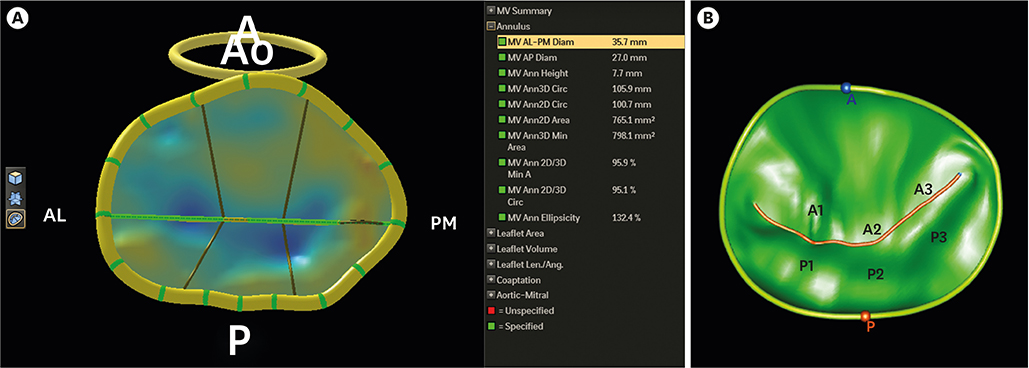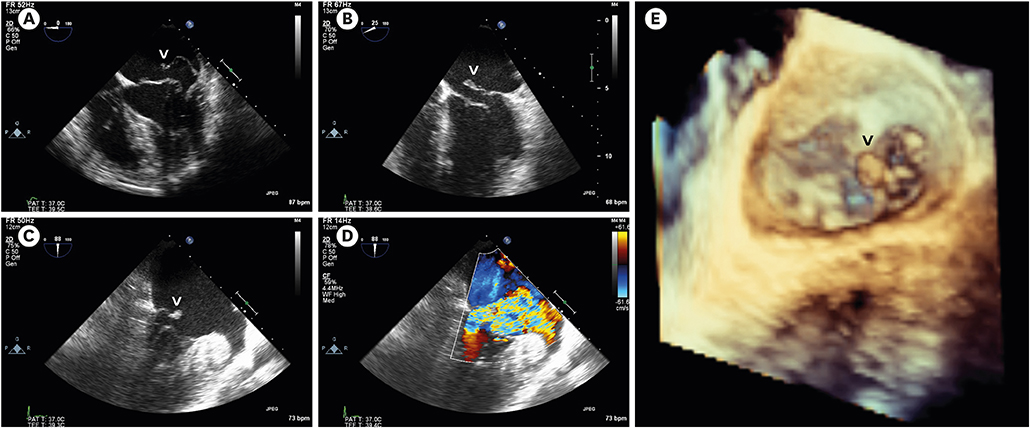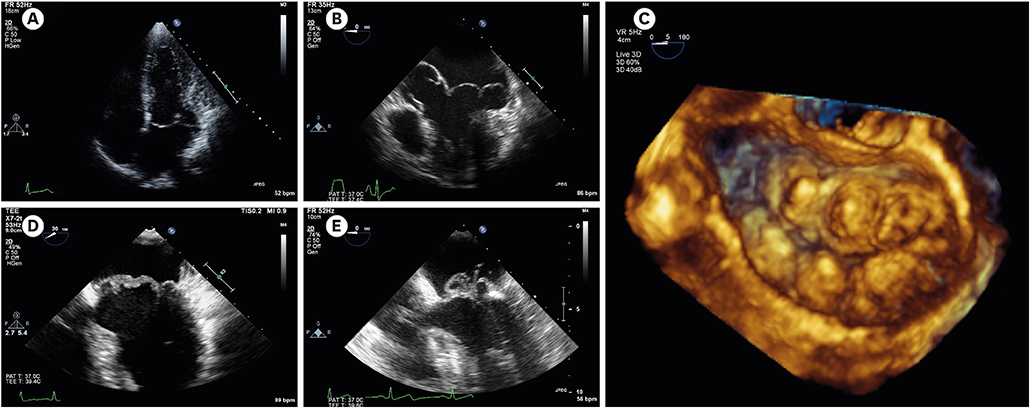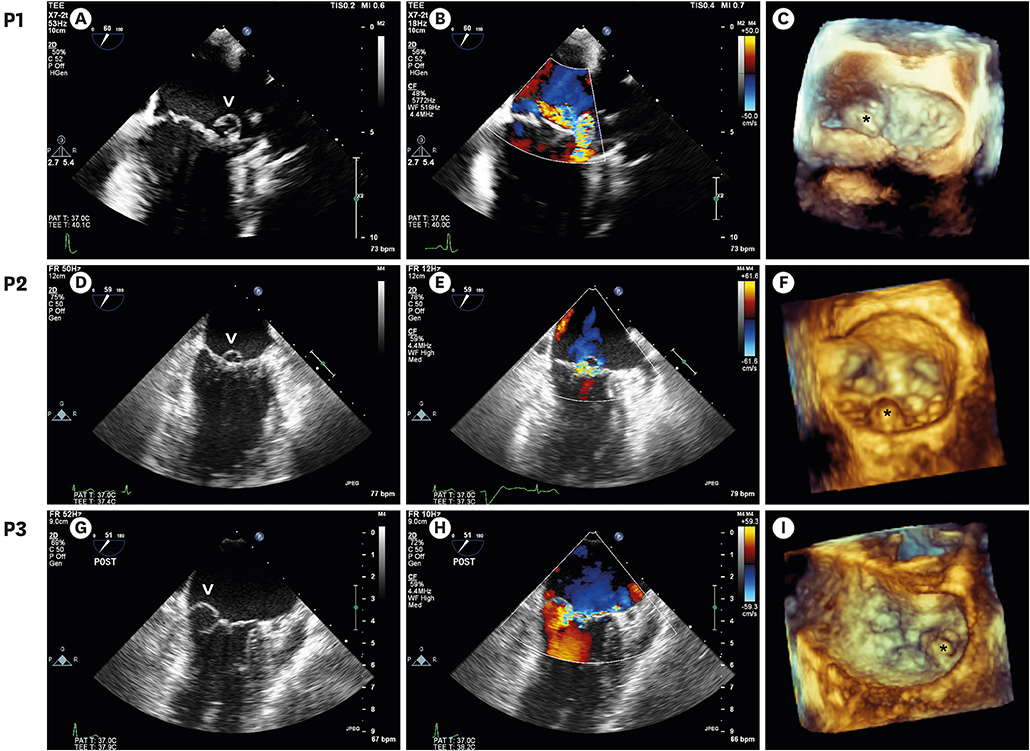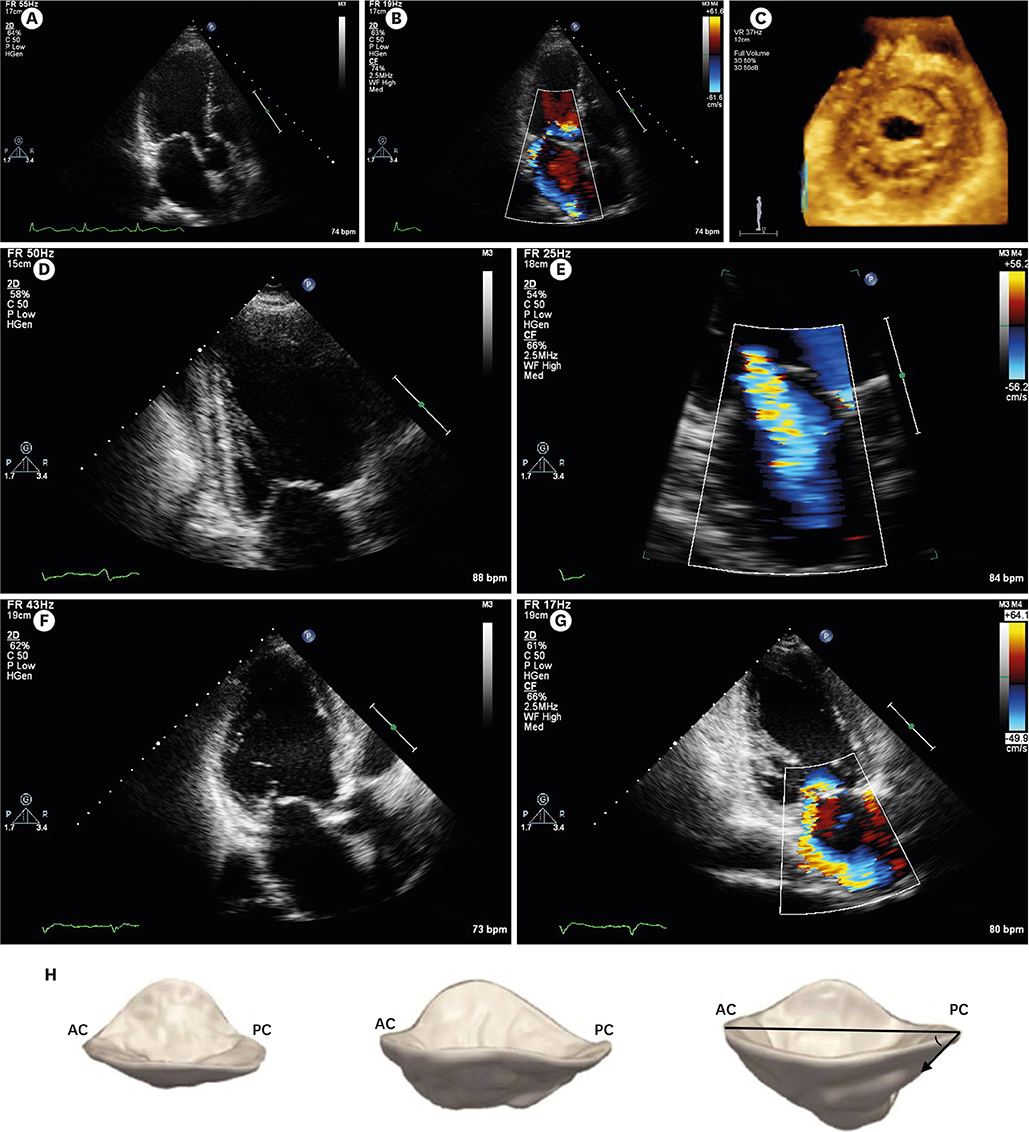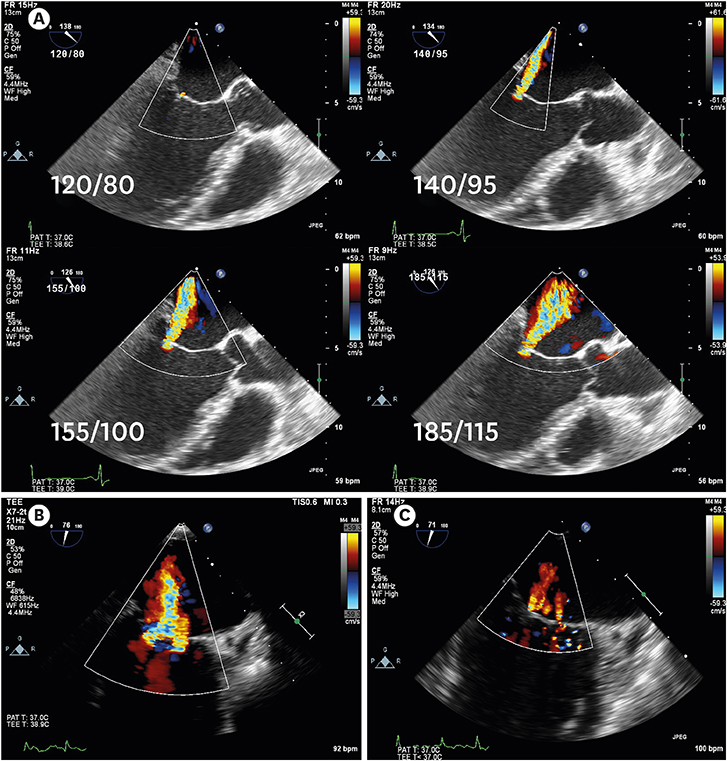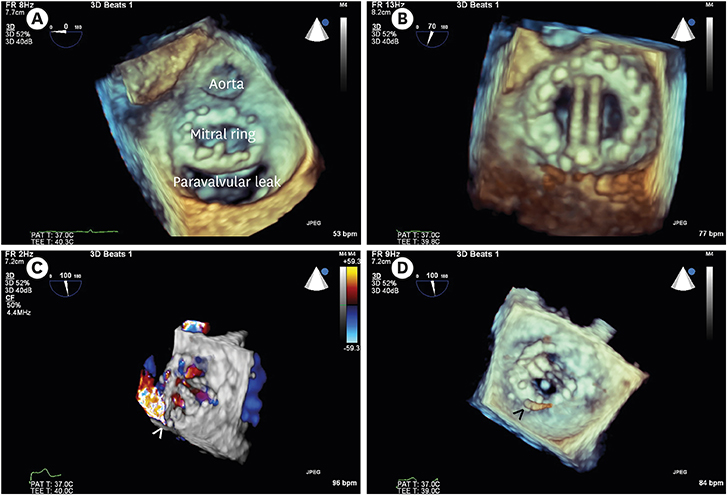J Cardiovasc Imaging.
2019 Jul;27(3):187-199. 10.4250/jcvi.2019.27.e29.
A Modified Echocardiographic Classification of Mitral Valve Regurgitation Mechanism: The Role of Three-dimensional Echocardiography
- Affiliations
-
- 1Department of Cardiology, Thoraxcenter, Erasmus University Medical Center, Rotterdam, the Netherlands. l.delaat@erasmusmc.nl
- 2Department of Cardiothoracic Surgery, Thoraxcenter, Erasmus University Medical Center, Rotterdam, the Netherlands.
- KMID: 2456854
- DOI: http://doi.org/10.4250/jcvi.2019.27.e29
Abstract
- In this report, we provide an overview of a new, updated echocardiographic classification of mitral regurgitation mechanisms to provide a more comprehensive and detailed assessment of mitral valve disorders. This is relevant to modern mitral valve repair techniques, with special attention to the added value of 3D-echocardiography.
MeSH Terms
Figure
Reference
-
1. Surkova E, Muraru D, Aruta P, et al. Current clinical applications of three-dimensional echocardiography: When the technique makes the difference. Curr Cardiol Rep. 2016; 18:109.
Article2. Lang RM, Badano LP, Tsang W, et al. EAE/ASE recommendations for image acquisition and display using three-dimensional echocardiography. Eur Heart J Cardiovasc Imaging. 2012; 13:1–46.3. McGhie JS, de Groot-de Laat L, Ren B, et al. Transthoracic two-dimensional xPlane and three-dimensional echocardiographic analysis of the site of mitral valve prolapse. Int J Cardiovasc Imaging. 2015; 31:1553–1560.
Article4. McGhie JS, Vletter WB, de Groot-de Laat LE, et al. Contributions of simultaneous multiplane echocardiographic imaging in daily clinical practice. Echocardiography. 2014; 31:245–254.
Article5. Carpentier A. Cardiac valve surgery--the “French correction”. J Thorac Cardiovasc Surg. 1983; 86:323–337.
Article6. de Groot-de Laat LE, Ren B, McGhie J, et al. The role of experience in echocardiographic identification of location and extent of mitral valve prolapse with 2D and 3D echocardiography. Int J Cardiovasc Imaging. 2016; 32:1171–1177.
Article7. Shah PM, Raney AA. New echocardiography-based classification of mitral valve pathology: relevance to surgical valve repair. J Heart Valve Dis. 2012; 21:37–40.8. Shah PM, Raney AA. Echocardiography in mitral regurgitation with relevance to valve surgery. J Am Soc Echocardiogr. 2011; 24:1086–1091.
Article9. Ben Zekry S, Nagueh SF, Little SH, et al. Comparative accuracy of two- and three-dimensional transthoracic and transesophageal echocardiography in identifying mitral valve pathology in patients undergoing mitral valve repair: initial observations. J Am Soc Echocardiogr. 2011; 24:1079–1085.
Article10. Gutiérrez-Chico JL, Zamorano Gómez JL, Rodrigo-López JL, et al. Accuracy of real-time 3-dimensional echocardiography in the assessment of mitral prolapse. Is transesophageal echocardiography still mandatory? Am Heart J. 2008; 155:694–698.
Article11. Beraud AS, Schnittger I, Miller DC, Liang DH. Multiplanar reconstruction of three-dimensional transthoracic echocardiography improves the presurgical assessment of mitral prolapse. J Am Soc Echocardiogr. 2009; 22:907–913.
Article12. Dal-Bianco JP, Beaudoin J, Handschumacher MD, Levine RA. Basic mechanisms of mitral regurgitation. Can J Cardiol. 2014; 30:971–981.
Article13. Thompson KA, Shiota T, Tolstrup K, Gurudevan SV, Siegel RJ. Utility of three-dimensional transesophageal echocardiography in the diagnosis of valvular perforations. Am J Cardiol. 2011; 107:100–102.
Article14. Wyss CA, Enseleit F, van der Loo B, Grünenfelder J, Oechslin EN, Jenni R. Isolated cleft in the posterior mitral valve leaflet: a congenital form of mitral regurgitation. Clin Cardiol. 2009; 32:553–560.
Article15. Looi JL, Lee AP, Wan S, et al. Diagnosis of cleft mitral valve using real-time 3-dimensional transesophageal echocardiography. Int J Cardiol. 2013; 168:1629–1630.
Article16. Guerreiro C, Fonseca C, Ribeiro J, Fontes-Carvalho R. Isolated cleft of the posterior mitral valve leaflet: the value of 3DTEE in the evaluation of mitral valve anatomy. Echocardiography. 2016; 33:1265–1266.
Article17. Lee AP, Jin CN, Fan Y, Wong RHL, Underwood MJ, Wan S. Functional implication of mitral annular disjunction in mitral valve prolapse: a quantitative dynamic 3D echocardiographic study. JACC Cardiovasc Imaging. 2017; 10:1424–1433.18. Ennezat PV, Maréchaux S, Pibarot P, Le Jemtel TH. Secondary mitral regurgitation in heart failure with reduced or preserved left ventricular ejection fraction. Cardiology. 2013; 125:110–117.
Article19. Oh JK, Seward JB, Tajik AJ. The Echo Manual. 3rd ed. Philadelphia: Lippincott Williams & Wilkins;2006. p. 211.20. Galiuto L, Fox K, Sicari R, Zamorano JL, editors. The EAE Textbook of Echocardiography. Oxford: Oxford University Press;2011. p. 38–39.21. Otto CM. Textbook of Clinical Echocardiography. 4th ed. Philadelphia: Saunders Elsevier;2009. p. 35–60.22. Anwar AM, Soliman OI, Nemes A, et al. Assessment of mitral annulus size and function by real-time 3-dimensional echocardiography in cardiomyopathy: comparison with magnetic resonance imaging. J Am Soc Echocardiogr. 2007; 20:941–948.
Article23. Foster GP, Dunn AK, Abraham S, Ahmadi N, Sarraf G. Accurate measurement of mitral annular dimensions by echocardiography: importance of correctly aligned imaging planes and anatomic landmarks. J Am Soc Echocardiogr. 2009; 22:458–463.
Article24. Ren B, de Groot-de Laat LE, McGhie J, Vletter WB, Ten Cate FJ, Geleijnse ML. Geometric errors of the pulsed-wave Doppler flow method in quantifying degenerative mitral valve regurgitation: a three-dimensional echocardiography study. J Am Soc Echocardiogr. 2013; 26:261–269.
Article25. Adams DH, Anyanwu AC. The cardiologist's role in increasing the rate of mitral valve repair in degenerative disease. Curr Opin Cardiol. 2008; 23:105–110.
Article26. Adams DH, Anyanwu AC. Seeking a higher standard for degenerative mitral valve repair: begin with etiology. J Thorac Cardiovasc Surg. 2008; 136:551–556.
Article27. Zamorano J, Cordeiro P, Sugeng L, et al. Real-time three-dimensional echocardiography for rheumatic mitral valve stenosis evaluation: an accurate and novel approach. J Am Coll Cardiol. 2004; 43:2091–2096.
Article28. Baumgartner H, Hung J, Bermejo J, et al. Echocardiographic assessment of valve stenosis: EAE/ASE recommendations for clinical practice. Eur J Echocardiogr. 2009; 10:1–25.
Article29. Anwar AM, Attia WM, Nosir YF, et al. Validation of a new score for the assessment of mitral stenosis using real-time three-dimensional echocardiography. J Am Soc Echocardiogr. 2010; 23:13–22.
Article30. Francis L, Finley A, Hessami W. Use of three-dimensional transesophageal echocardiography to evaluate mitral valve morphology for risk stratification prior to mitral valvuloplasty. Echocardiography. 2017; 34:303–305.
Article31. Agricola E, Oppizzi M, Maisano F, et al. Echocardiographic classification of chronic ischemic mitral regurgitation caused by restricted motion according to tethering pattern. Eur J Echocardiogr. 2004; 5:326–334.
Article32. Agricola E, Oppizzi M, Pisani M, Meris A, Maisano F, Margonato A. Ischemic mitral regurgitation: mechanisms and echocardiographic classification. Eur J Echocardiogr. 2008; 9:207–221.
Article33. Silbiger JJ. Mechanistic insights into ischemic mitral regurgitation: echocardiographic and surgical implications. J Am Soc Echocardiogr. 2011; 24:707–719.
Article34. Levine RA, Schwammenthal E. Ischemic mitral regurgitation on the threshold of a solution: from paradoxes to unifying concepts. Circulation. 2005; 112:745–758.35. Veronesi F, Corsi C, Sugeng L, et al. Quantification of mitral apparatus dynamics in functional and ischemic mitral regurgitation using real-time 3-dimensional echocardiography. J Am Soc Echocardiogr. 2008; 21:347–354.
Article36. Toida R, Watanabe N, Obase K, et al. Prognostic implication of three-dimensional mitral valve tenting geometry in dilated cardiomyopathy. J Heart Valve Dis. 2015; 24:577–585.37. Bouma W, Lai EK, Levack MM, et al. Preoperative three-dimensional valve analysis predicts recurrent ischemic mitral regurgitation after mitral annuloplasty. Ann Thorac Surg. 2016; 101:567–575. discussion 575.
Article38. Sherrid MV, Balaram S, Kim B, Axel L, Swistel DG. The mitral valve in obstructive hypertrophic cardiomyopathy: a test in context. J Am Coll Cardiol. 2016; 67:1846–1858.39. Geleijnse ML, Krenning BJ, Nemes A, et al. Incidence, pathophysiology, and treatment of complications during dobutamine-atropine stress echocardiography. Circulation. 2010; 121:1756–1767.
Article40. Zamorano JL, Badano LP, Bruce C, et al. EAE/ASE recommendations for the use of echocardiography in new transcatheter interventions for valvular heart disease. Eur Heart J. 2011; 32:2189–2214.
Article41. Faletra FF, Ramamurthi A, Dequarti MC, Leo LA, Moccetti T, Pandian N. Artifacts in three-dimensional transesophageal echocardiography. J Am Soc Echocardiogr. 2014; 27:453–462.
Article
- Full Text Links
- Actions
-
Cited
- CITED
-
- Close
- Share
- Similar articles
-
- Echocardiographic Assessment of Mitral Valve Regurgitation
- Assessment of Mitral Stenosis by Doppler Echocardiography: Influence of Regurgitation on Doppler Pressure Half-Time
- Assessment of Mitral Valve Complex by Three-Dimensional Echocardiography: Therapeutic Strategy for Functional Mitral Regurgitation
- Doppler Echocardiographic Assessment of Diastolic Pressure Gradient and Mitral Valve Area in Mitral Valvular Disease
- Echocardiographic Evaluation of the Functional Mitral Regurgitation



